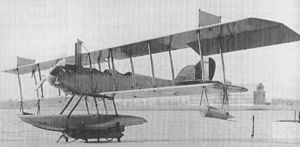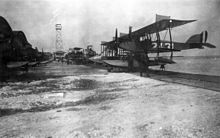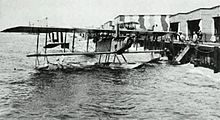- Curtiss Model N
-
Model N Curtiss N-9H Role floatplane Manufacturer Curtiss, Burgess Company Designer Glenn Curtiss First flight 1916 Primary user United States Navy Number built 560 The Curtiss N-9 was a seaplane variant of the Curtiss JN-4 "Jenny" military trainer used during the First World War by the United States Navy.
Contents
Design and development
As a seaplane, the N-9 was equipped with a single central pontoon mounted under the fuselage. A small float was fitted under each wingtip. With the additional weight of the pontoon, a number of structural and aerodynamic changes were required, the design of which made use of wind tunnel data developed at the Massachusetts Institute of Technology, meaning the N-9 was the first US Naval aircraft to incorporate wind tunnel data directly into its design. The wingspan was stretched an additional 10 ft ( m), the fuselage was lengthened, the tail surfaces were enlarged, and stabilizing fins were added to the top of the top wing. The N-9 was initially powered by a 100 hp (75 kW) Curtiss OXX-6 engine.
Curtiss was awarded an initial contract for 30 aircraft in August 1916, and an additional 14 were ordered by the US Army, which maintained a small seaplane operation. It became quickly apparent that the aircraft was underpowered, so Curtiss replaced the engine with a 150 hp (112 kW) Hispano-Suiza, manufactured in the US under license by Wright-Martin's Simplex division (later Wright Aeronautical). The aircraft was redesignated N-9H.
A total of 560 N-9s were built during the war, most of which were "H" models. Only 100 were actually built by Curtiss. Most were built under license by the Burgess Company of Marblehead, Massachusetts. Fifty others were assembled after the war, from spare components and engines by the Navy at the Pensacola Naval Air Station.
Operational history
Over 2,500 US Navy pilots received their seaplane training in the N-9s. Besides this primary role, though, the aircraft was also used to help develop ship-borne aircraft operations during the war, especially the development of ship-mounted launch catapults. In 1917, several N-9s were provided to the Sperry Gyroscope Company for conversion to the Hewitt-Sperry Automatic Airplane configuration, flight testing the new autopilot components intended to be used in pilotless "aerial torpedoes".
The N-9s were retired by the Navy in 1927, as more modern trainers became available. Only one example of the type has survived, and is now a part of the National Air and Space Museum collection. Originally on display at Chicago's Museum of Science and Industry, it was transferred back to the Navy pending transport to NASM. It was fully restored in 1966 by the Naval Air Engineering Laboratory in Philadelphia, Pennsylvania.
Variants
- Model N
- 1914 two-seat trainer powered by 100 hp (75 kW) Curtiss OXX engine, similar to Model J but with different aerofoil section. One built for US Army. Later rebuilt as Model O with side-by side seating.[1]
- Model N-8
- Production version of N for US Army, powered by 90 hp (67 kW) Curtiss OX-2 engine. Equivalent to JN-3. 4 built 1915.[2]
- Model N-9
- Two-seat single-engined trainer floatplane.
- Model N-9N
- Powered by a 150 hp (112 kW) Wright A piston engine.
- Model N-9C
- The original N-9 floatplane with the 100 hp (75 kW) engine, later became known as the N-9C.
Operators
Specifications (N-9H)
Data from Curtiss Aircraft 1907–1947[3]
General characteristics
- Crew: 2
- Length: 30 ft 10 in (9.39 m)
- Wingspan: 53 ft 4 in (16.25 m)
- Height: 10 ft 11 in (3.32 m)
- Wing area: 496 ft² (46.07 m²)
- Airfoil: RAF 6[4]
- Empty weight: 2,140 lb (971 kg)
- Loaded weight: 2,750 lb (1,247 kg)
- Powerplant: 1 × Wright-Hispano A water-cooled V8 engine, 150 hp (112 kW)
Performance
- Maximum speed: 78 mph (68 knots, 126 km/h)
- Service ceiling: 6,600 ft (2,012 m)
- Climb to 3,240 ft (987 m): 10 min
References
- Notes
- Bibliography
- Bowers, Peter M. Curtiss Aircraft 1907–1947. London: Putnam, 1979. ISBN 0-370-10029-8.
- National Air and Space Museum information
Aircraft produced by Curtiss and Curtiss-Wright Manufacturer
designationsModel letters: C • D • E • F • G • GS • H • J • K • L • M • N • PN • JN • R • S
Model numbers: 1 • 2 • 3 • 4 • 5 • 6 • 7 • 8 • 9 • 10 • 11 • 12 • 13 • 14 • 16 • 17 • 18 • 19 • 20 • 21 • 23 • 24 • 26 • 28 • 31 • 32 • 33 • 34 • 35 • 36 • 37 • 38 • 39 • 40 • 41 • 42 • 43 • 44 • 47 • 48 • 49 • 50 • 51 • 52 • 53 • 54 • 55 • 56 • 57 • 58 • 59A/59B • 60 • 61 • 62 • 63 • 64 • 66 • 67 • 68 • 69 • 70 • 71 • 72 • 73 • 75 • 76 • 77 • 79 • 81 • 82 • 84 • 85 • 86 • 87 • 88 • 90 • 91 • 94 • 95 • 96 • 97 • 98 •
"CW" models: CW-1 • CW-2 • CW-3 • CW-4 • CW-5 • CW-6 • CW-7 • CW-8 • CW-9 • CW-10 • CW-11 • CW-12 • CW-14 • CW-15 • CW-16 • CW-17 • CW-18 • CW-19 • CW-20 • CW-21 • CW-22 • CW-23 • CW-24 • CW-25 • CW-27 • CW-29 • CW-32
By role Experimental: No. 1 • Model C • Tanager
Racing: No. 2 • CR • R2C • R3C
General utility: Model D • Model E • Model F • Robin • Thrush
Maritime patrol: Model H • HS-1L and -2L
Training: Model L • Model JN • Fledgling • AT-4 Hawk • AT-5 Hawk
Fighters: 18 • PW-8 • P-1 • P-2 • P-3 • P-4 • P-5 • P-6 • XP-31 • P-36 • P-40 • XP-46 • XP-53 • YP-60 • XP-62 • XP-71 • XP-87
Naval Fighters: HA • FC • F2C • F3C • F4C • F6C • F7C • F8C • F9C • F10C • F11C • XF12C • F13C • XF14C • XF15C
Airliners: Eagle • Condor II • Kingbird
Naval Scouts/Dive Bombers: CS • GS • S2C • XS3C • S4C • SC • SBC • SB2C • XSB3C • SOC • SO2C • SO3C
Observation: O-1 • O-12 • O-13 • O-16 • O-18 • O-26 • O-39 • O-40 • O-52
Naval Observation: OC • O2C • O3C
Naval Bombers: 24 • BFC • BF2C • XBTC • XBT2C
Ground Attack: A-3 • A-4 • A-5 • A-6 • A-8 • YA-10 • A-12 • YA-14 • A-25 • A-40 • XA-43
Licensed production: NBS-1
Lists relating to aviation General Aircraft (manufacturers) · Aircraft engines (manufacturers) · Airlines (defunct) · Airports · Civil authorities · Museums · Registration prefixes · Rotorcraft (manufacturers) · TimelineMilitary Accidents/incidents Records Categories:- United States military trainer aircraft 1910–1919
- Curtiss aircraft
- Seaplanes and flying boats
- Single-engine aircraft
Wikimedia Foundation. 2010.



